2015最新PEP六年级下册英语教案
- 格式:doc
- 大小:767.00 KB
- 文档页数:53
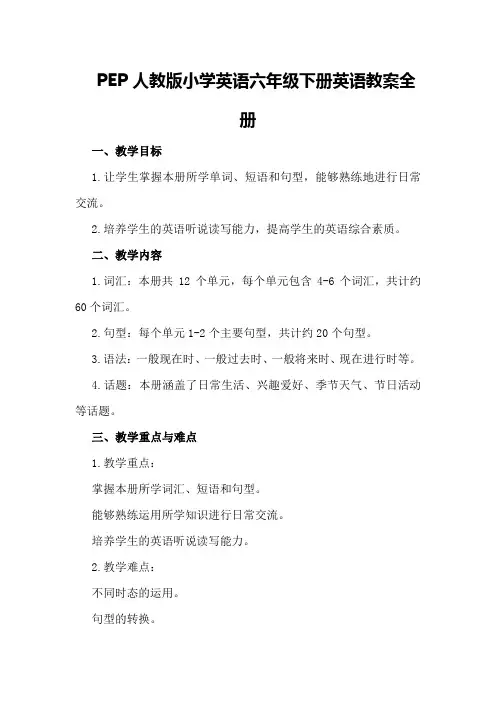
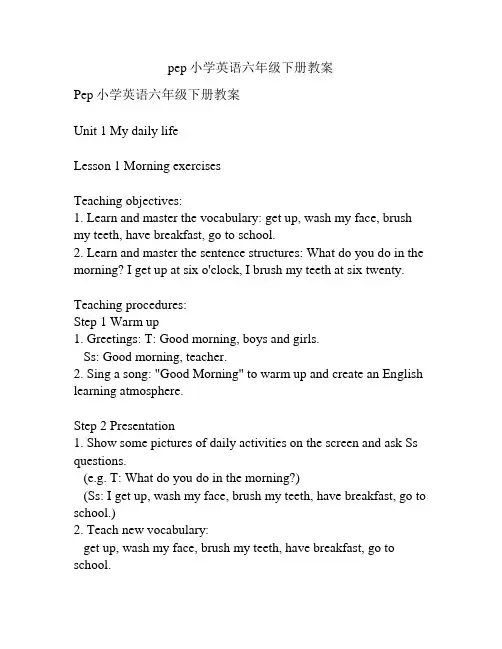
pep小学英语六年级下册教案Pep小学英语六年级下册教案Unit 1 My daily lifeLesson 1 Morning exercisesTeaching objectives:1. Learn and master the vocabulary: get up, wash my face, brush my teeth, have breakfast, go to school.2. Learn and master the sentence structures: What do you do in the morning? I get up at six o'clock, I brush my teeth at six twenty. Teaching procedures:Step 1 Warm up1. Greetings: T: Good morning, boys and girls.Ss: Good morning, teacher.2. Sing a song: "Good Morning" to warm up and create an English learning atmosphere.Step 2 Presentation1. Show some pictures of daily activities on the screen and ask Ss questions.(e.g. T: What do you do in the morning?)(Ss: I get up, wash my face, brush my teeth, have breakfast, go to school.)2. Teach new vocabulary:get up, wash my face, brush my teeth, have breakfast, go to school.(T: How do you say "起床" in English?)(Ss: get up.)(T: Excellent!)Show the words on the screen and read them together.Step 3 Practice1. T: Now let's practice the pronunciation of these words. Please repeat after me.Practice reading the words: get up, wash my face, brush my teeth, have breakfast, go to school.2. Listen and repeat the sentence patterns.(T: I get up at six o'clock. You get up at what time?)(Ss: I get up at six o'clock.)(T: I brush my teeth at six twenty. You brush your teeth at what time?)(Ss: I brush my teeth at six twenty.)And so on with other sentence patterns.Step 4 Consolidation1. Work in pairs and ask questions to each other using the sentence patterns learned.(e.g. S1: What do you do in the morning?)(S2: I get up at six o'clock. I brush my teeth at six twenty.)2. Make a short dialogue with a partner using the sentence structures.(e.g. S1: What do you do in the morning?)(S2: I get up at six o'clock. I wash my face at six ten. I brush my teeth at six twenty. I have breakfast at six thirty.)(S1: Wow, you have a very regular routine. Good job!)Step 5 Production1. Ask Ss to draw a picture of their daily routine in the morning.2. Each student presents their picture and describes their routine to the class using the new vocabulary and sentence structures learned. Step 6 Homework1. Review the new vocabulary and sentence patterns.2. Write a short paragraph describing your daily routine in the morning using the new vocabulary and sentence structures learned. Unit 2 At the weekendLesson 1 Let's celebrate!Teaching objectives:1. Learn and master the vocabulary: celebrate, get together, wear, blow out, make a wish.2. Learn and master the sentence structures: What do you do at the weekend? We celebrate birthdays, wear nice clothes, blow out candles, make a wish.Teaching procedures:Step 1 Warm up1. Greetings: T: Good morning, boys and girls.Ss: Good morning, teacher.2. Play a song: "Happy Birthday" to warm up and create an English learning atmosphere.Step 2 Presentation1. Show some pictures of celebration activities on the screen andask Ss questions.(e.g. T: What do you usually do to celebrate birthdays?)(Ss: We get together, wear nice clothes, blow out candles, makea wish.)2. Teach new vocabulary:celebrate, get together, wear, blow out, make a wish.(T: How do you say "庆祝" in English?)(Ss: celebrate.)(T: Great!)Show the words on the screen and read them together.Step 3 Practice1. T: Now let's practice the pronunciation of these words. Please repeat after me.Practice reading the words: celebrate, get together, wear, blow out, make a wish.2. Listen and repeat the sentence patterns.(T: What do you do at the weekend?)(Ss: We celebrate birthdays, wear nice clothes, blow out candles, make a wish.)And so on with other sentence patterns.Step 4 Consolidation1. Work in pairs and ask questions to each other using the sentence patterns learned.(e.g. S1: What do you do at the weekend?)(S2: We celebrate birthdays, wear nice clothes, blow out candles, make a wish.)2. Make a short dialogue with a partner using the sentence structures.(e.g. S1: What do you do at the weekend?)(S2: We celebrate birthdays at home. We invite friends and family to get together. We wear nice clothes and blow out candles on the birthday cake. Then we make a wish.)Step 5 Production1. Ask Ss to draw a picture of their favorite celebration activity.2. Each student presents their picture and describes their favorite celebration activity to the class using the new vocabulary and sentence structures learned.Step 6 Homework1. Review the new vocabulary and sentence patterns.2. Write a paragraph describing your favorite celebration activity using the new vocabulary and sentence structures learned.。
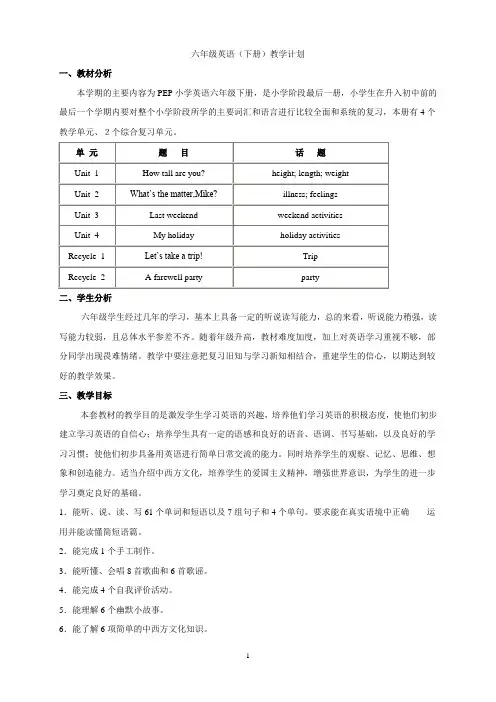
六年级英语(下册)教学计划一、教材分析本学期的主要内容为PEP小学英语六年级下册,是小学阶段最后一册,小学生在升入初中前的最后一个学期内要对整个小学阶段所学的主要词汇和语言进行比较全面和系统的复习,本册有4个教学单元、2个综合复习单元。
二、学生分析六年级学生经过几年的学习,基本上具备一定的听说读写能力,总的来看,听说能力稍强,读写能力较弱,且总体水平参差不齐。
随着年级升高,教材难度加度,加上对英语学习重视不够,部分同学出现畏难情绪。
教学中要注意把复习旧知与学习新知相结合,重建学生的信心,以期达到较好的教学效果。
三、教学目标本套教材的教学目的是激发学生学习英语的兴趣,培养他们学习英语的积极态度,使他们初步建立学习英语的自信心;培养学生具有一定的语感和良好的语音、语调、书写基础,以及良好的学习习惯;使他们初步具备用英语进行简单日常交流的能力。
同时培养学生的观察、记忆、思维、想象和创造能力。
适当介绍中西方文化,培养学生的爱国主义精神,增强世界意识,为学生的进一步学习奠定良好的基础。
1.能听、说、读、写61个单词和短语以及7组句子和4个单句。
要求能在真实语境中正确运用并能读懂简短语篇。
2.能完成1个手工制作。
3.能听懂、会唱8首歌曲和6首歌谣。
4.能完成4个自我评价活动。
5.能理解6个幽默小故事。
6.能了解6项简单的中西方文化知识。
四、教学措施(一)词汇教学(Let’s learn)1.注重词汇的呈现方式2.利用Let’s start部分引入话题、引出新词和新句型3.在实际交流当中教学单词4.充分发挥单词卡片的作用(二)对话教学(Let’s talk)1.在听力活动中感知新的语言(Let’s try)2.理解语言的基础上学说、操练语言(1)抓住主句型,替换关键词操练住句型。
(2)在趣味游戏和任务型活动中学说、巩固新句型。
(3)在会说的基础上运用重点句型。
(4)在会用的基础上进行句型书写。
(三)阅读教学(Let’s read )1.复习巩固本部分重点词汇和句型,可以采用游戏、竞赛或师生自由会话等形式。
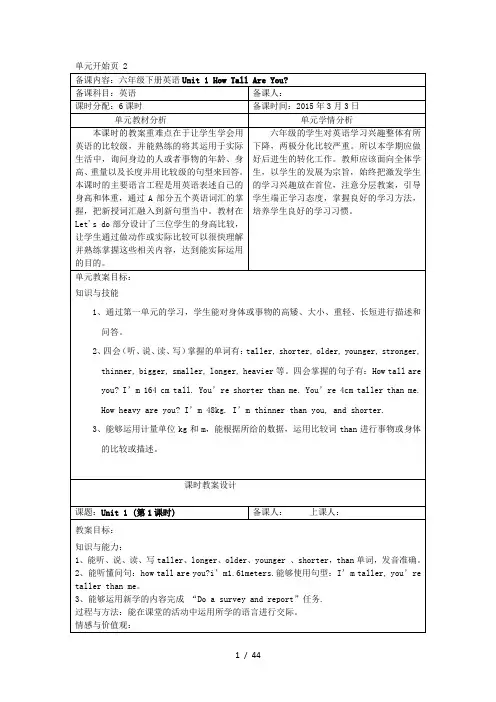
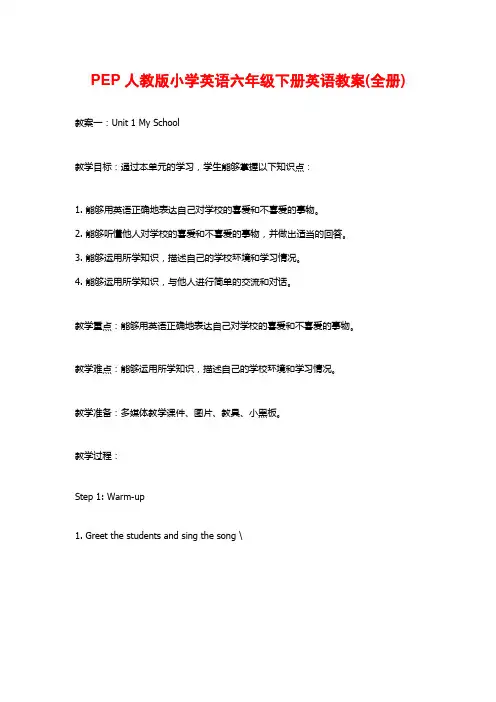
PEP人教版小学英语六年级下册英语教案(全册) 教案一:Unit 1 My School
教学目标:通过本单元的学习,学生能够掌握以下知识点:
1. 能够用英语正确地表达自己对学校的喜爱和不喜爱的事物。
2. 能够听懂他人对学校的喜爱和不喜爱的事物,并做出适当的回答。
3. 能够运用所学知识,描述自己的学校环境和学习情况。
4. 能够运用所学知识,与他人进行简单的交流和对话。
教学重点:能够用英语正确地表达自己对学校的喜爱和不喜爱的事物。
教学难点:能够运用所学知识,描述自己的学校环境和学习情况。
教学准备:多媒体教学课件、图片、教具、小黑板。
教学过程:
Step 1: Warm-up
1. Greet the students and sing the song \。
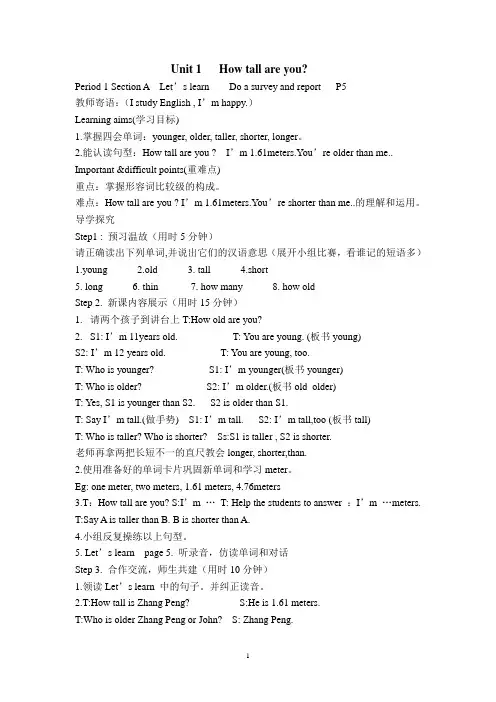
Unit 1 How tall are you?Period 1 Section A Let’s learn Do a survey and report P5教师寄语:(I study English , I’m happy.)Learning aims(学习目标)1.掌握四会单词:younger, older, taller, shorter, longer。
2.能认读句型:How tall are you ? I’m 1.61meters.You’re older than me.. Important &difficult points(重难点)重点:掌握形容词比较级的构成。
难点:How tall are you ? I’m 1.61meters.You’re shorter than me..的理解和运用。
导学探究Step1 : 预习温故(用时5分钟)请正确读出下列单词,并说出它们的汉语意思(展开小组比赛,看谁记的短语多)1.young______2.old______3. tall______4.short______5. long______6. thin______7. how many______8. how old______Step 2. 新课内容展示(用时15分钟)1.请两个孩子到讲台上T:How old are you?2.S1: I’m 11years old. T: You are young. (板书young)S2: I’m 12 years old. T: You are young, too.T: Who is younger? S1: I’m younger(板书younger)T: Who is older? S2: I’m older.(板书old_older)T: Yes, S1 is younger than S2. S2 is older than S1.T: Say I’m tall.(做手势) S1: I’m tall. S2: I’m tall,too (板书tall)T: Who is taller? Who is shorter? Ss:S1 is taller , S2 is shorter.老师再拿两把长短不一的直尺教会longer, shorter,than.2.使用准备好的单词卡片巩固新单词和学习meter。
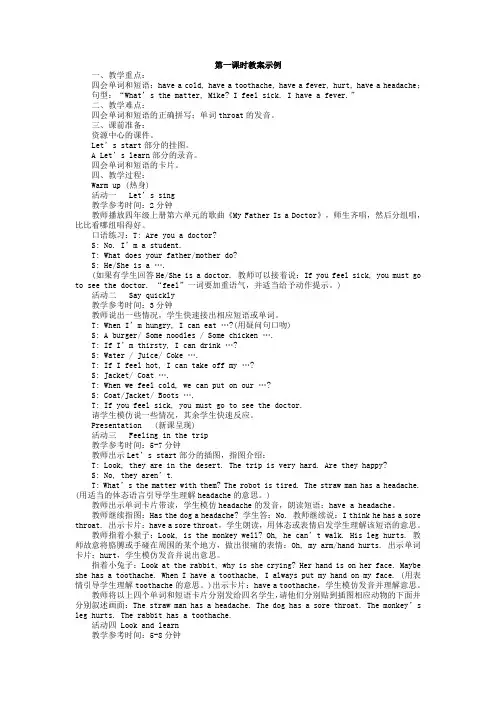
第一课时教案示例一、教学重点:四会单词和短语:have a cold, have a toothache, have a fever, hurt, have a headache;句型:“What’s the matter, Mike? I feel sick. I have a fever.”二、教学难点:四会单词和短语的正确拼写;单词throat的发音。
三、课前准备:资源中心的课件。
Let’s start部分的挂图。
A Let’s learn部分的录音。
四会单词和短语的卡片。
四、教学过程:Warm up (热身)活动一 Let’s sing教学参考时间:2分钟教师播放四年级上册第六单元的歌曲《My Father Is a Doctor》,师生齐唱,然后分组唱,比比看哪组唱得好。
口语练习:T: Are you a doctor?S: No. I’m a student.T: What does your father/mother do?S: He/She is a ….(如果有学生回答He/She is a doctor. 教师可以接着说:If you feel sick, you must go to see the doctor. “feel”一词要加重语气,并适当给予动作提示。
)活动二 Say quickly教学参考时间:3分钟教师说出一些情况,学生快速接出相应短语或单词。
T: When I’m hungry, I can eat …?(用疑问句口吻)S: A burger/ Some noodles / Some chicken ….T: If I’m thirsty, I can drink …?S: Water / Juice/ Coke ….T: If I feel hot, I can take off my …?S: Jacket/ Coat ….T: When we feel cold, we can put on our …?S: Coat/Jacket/ Boots ….T: If you feel sick, you must go to see the doctor.请学生模仿说一些情况,其余学生快速反应。
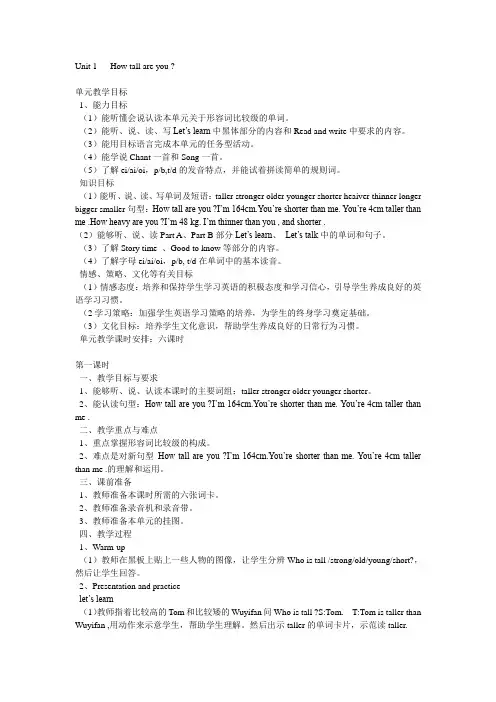
Unit 1 How tall are you ?单元教学目标1、能力目标(1)能听懂会说认读本单元关于形容词比较级的单词。
(2)能听、说、读、写Let’s learn中黑体部分的内容和Read and write中要求的内容。
(3)能用目标语言完成本单元的任务型活动。
(4)能学说Chant一首和Song一首。
(5)了解ei/ai/oi,p/b,t/d的发音特点,并能试着拼读简单的规则词。
知识目标(1)能听、说、读、写单词及短语:taller stronger older younger shorter heaiver thinner longer bigger smaller句型:How tall are you ?I’m 164cm.You’re shorter than me. You’re 4cm taller than me .How heavy are you ?I’m 48 kg. I’m thinner than you , and shorter .(2)能够听、说、读Part A、Part B部分Let’s learn、Let’s talk中的单词和句子。
(3)了解Story time 、Good to know等部分的内容。
(4)了解字母ei/ai/oi,p/b, t/d在单词中的基本读音。
情感、策略、文化等有关目标(1)情感态度:培养和保持学生学习英语的积极态度和学习信心,引导学生养成良好的英语学习习惯。
(2学习策略:加强学生英语学习策略的培养,为学生的终身学习奠定基础。
(3)文化目标:培养学生文化意识,帮助学生养成良好的日常行为习惯。
单元教学课时安排:六课时第一课时一、教学目标与要求1、能够听、说、认读本课时的主要词组:taller stronger older younger shorter。
2、能认读句型:How tall are you ?I’m 164cm.You’re shorter than me. You’re 4cm taller than me .二、教学重点与难点1、重点掌握形容词比较级的构成。
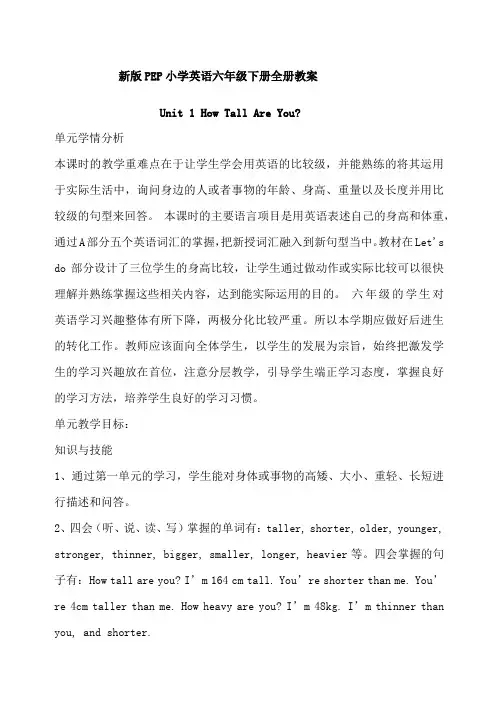
新版PEP小学英语六年级下册全册教案Unit 1 How Tall Are You?单元学情分析本课时的教学重难点在于让学生学会用英语的比较级,并能熟练的将其运用于实际生活中,询问身边的人或者事物的年龄、身高、重量以及长度并用比较级的句型来回答。
本课时的主要语言项目是用英语表述自己的身高和体重,通过A部分五个英语词汇的掌握,把新授词汇融入到新句型当中。
教材在Let's do部分设计了三位学生的身高比较,让学生通过做动作或实际比较可以很快理解并熟练掌握这些相关内容,达到能实际运用的目的。
六年级的学生对英语学习兴趣整体有所下降,两极分化比较严重。
所以本学期应做好后进生的转化工作。
教师应该面向全体学生,以学生的发展为宗旨,始终把激发学生的学习兴趣放在首位,注意分层教学,引导学生端正学习态度,掌握良好的学习方法,培养学生良好的学习习惯。
单元教学目标:知识与技能1、通过第一单元的学习,学生能对身体或事物的高矮、大小、重轻、长短进行描述和问答。
2、四会(听、说、读、写)掌握的单词有:taller, shorter, older, younger, stronger, thinner, bigger, smaller, longer, heavier等。
四会掌握的句子有:How tall are you? I’m 164 cm tall. You’re shorter than me. You’re 4cm taller than me. How heavy are you? I’m 48kg. I’m thinner than you, and shorter.3、能够运用计量单位kg和m,能根据所给的数据,运用比较词than进行事物或身体的比较或描述。
课时教学设计课题:Unit 1 (第1课时)教学目标:知识与能力:1、能听、说、读、写taller、longer、older、younger 、shorter,than 单词,发音准确。
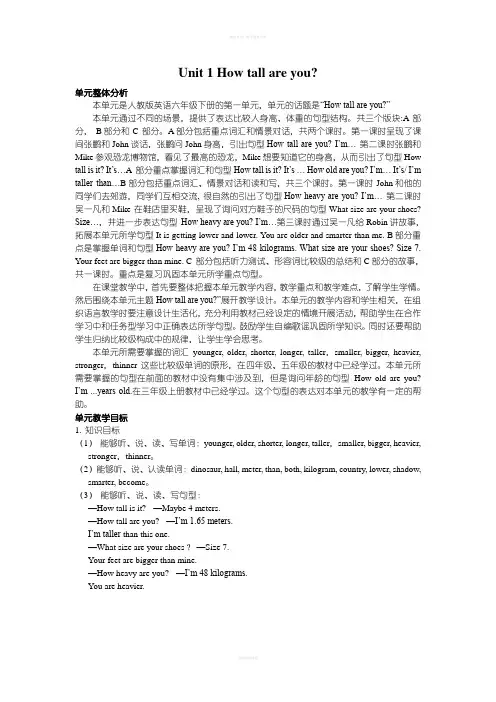
Unit 1 How tall are you?单元整体分析本单元是人教版英语六年级下册的第一单元,单元的话题是“How tall are you?”本单元通过不同的场景,提供了表达比较人身高、体重的句型结构。
共三个版块:A 部分,B部分和C 部分。
A部分包括重点词汇和情景对话,共两个课时。
第一课时呈现了课间张鹏和John谈话,张鹏问John身高,引出句型How tall are you? I’m… 第二课时张鹏和Mike参观恐龙博物馆,看见了最高的恐龙,Mike想要知道它的身高,从而引出了句型How tall is it? It’s…A 部分重点掌握词汇和句型How tall is it? It’s … How old are you? I’m… It’s/ I’m taller than…B部分包括重点词汇、情景对话和读和写,共三个课时。
第一课时John和他的同学们去郊游,同学们互相交流, 很自然的引出了句型How heavy are you? I’m… 第二课时吴一凡和Mike 在鞋店里买鞋,呈现了询问对方鞋子的尺码的句型What size are your shoes? Size…,并进一步表达句型How heavy are you? I’m…第三课时通过吴一凡给Robin讲故事,拓展本单元所学句型It is getting lower and lower. You are older and smarter than me. B部分重点是掌握单词和句型How heavy are you? I’m 48 kilograms. What size are your shoes? Size 7. Your feet are bigger than mine. C 部分包括听力测试、形容词比较级的总结和C部分的故事,共一课时。
重点是复习巩固本单元所学重点句型。
在课堂教学中,首先要整体把握本单元教学内容,教学重点和教学难点,了解学生学情。
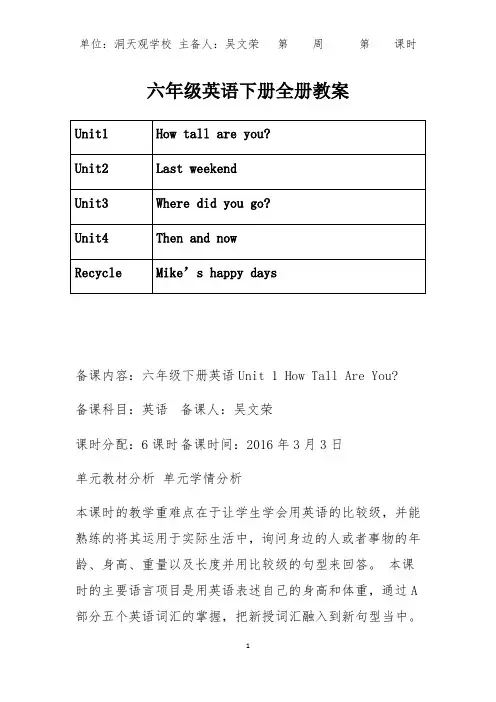
六年级英语下册全册教案Unit1How tall are you?Unit2Last weekendUnit3Where did you go?Unit4Then and nowRecycle Mike’s happy days备课内容:六年级下册英语Unit 1 How Tall Are You?备课科目:英语备课人:吴文荣课时分配:6课时备课时间:2016年3月3日单元教材分析单元学情分析本课时的教学重难点在于让学生学会用英语的比较级,并能熟练的将其运用于实际生活中,询问身边的人或者事物的年龄、身高、重量以及长度并用比较级的句型来回答。
本课时的主要语言项目是用英语表述自己的身高和体重,通过A 部分五个英语词汇的掌握,把新授词汇融入到新句型当中。
教材在Let's do部分设计了三位学生的身高比较,让学生通过做动作或实际比较可以很快理解并熟练掌握这些相关内容,达到能实际运用的目的。
六年级的学生对英语学习兴趣整体有所下降,两极分化比较严重。
所以本学期应做好后进生的转化工作。
教师应该面向全体学生,以学生的发展为宗旨,始终把激发学生的学习兴趣放在首位,注意分层教学,引导学生端正学习态度,掌握良好的学习方法,培养学生良好的学习习惯。
单元教学目标:知识与技能1、通过第一单元的学习,学生能对身体或事物的高矮、大小、重轻、长短进行描述和问答。
2、四会(听、说、读、写)掌握的单词有:taller, shorter, older, younger, stronger, thinner, bigger, smaller, longer, heavier等。
四会掌握的句子有:How tall are you? I’m 164 cm tall. You’re shorterthan me. You’re 4cm taller than me. How heavy are you? I’m 48kg. I’m thinner than you, and shorter.3、能够运用计量单位kg和m,能根据所给的数据,运用比较词than进行事物或身体的比较或描述。
教案(首页)
教案(首页)
教案(首页)
教案(首页)
D.washed my clothes
E.played football
1_____ 2.______ 3._____ 4._____ 5._____
二、写出下列动词的过去式。
1.wash______
2.stay_____
3.watch______
4.clean______
5.do ______
三、读一读, 选一选。
()1.你想问同学周末过得怎样, 可以说: ______.
A.How was your weekend ?
B.How old are you ?
( ) 2.你想问同学有多高, 可以说:_______.
A.How heavy are you ?
B.How old are you ?
( )3.你想告诉同学: 你周末过得很好, 可以说: ____.
A.I’m taller than you .
B.It was fine.
( ) 4.你想问同学上周末做了什么?可以说_____.
A .What did you do last weekend ? B.What are you going to do next weekend ?
()5.你想说: 它比我们俩加起来还高, 可以说: _______.
It’s taller than both of us together. B.It’s taller than the elephant.
教案(首页)
教案(首页)
教案(首页)
教案(首页)
教案(首页)
教案(首页)
教案(首页)
教案(首页)。
人教版pep六年级下英语教案5篇人教版pep六班级下英语教案3一、教学内容与分析:1.Fill in the blanks本部分供应学生26个字母,通过补全字母帮忙学生区别和辨认字母的大小写。
同时,让学生清楚26个字母的排序,认识其字母的代表单词。
2. Lets sing.本部分是一首字母歌,歌曲耳熟能熟,琅琅上口。
二、课前预备:1.师生预备已学过26个字母的大小写及其读音。
2.老师卡片,录音器材三.教学步骤1. 热身/ 复习(Warm-up/Revision)(1) 学生间进行日常对话。
(3) 将学生分两组,一边拍手,一边唱第一单元的ABC song。
2. 新课展示(Presentation)(1)字母接龙:老师任凭念出一个字母,学生马上反应出其字母前面或者后面一个字母。
完成课本第69 页Fill in the blanks的练习,或把它布置成家庭作业。
(2)Bingo 嬉戏:提前让学生在英语本上画出九方格,嬉戏开始前,先让学生写下自己喜爱的九个大写或者小写字母。
嬉戏开始,老师或者请一位学生随便念出三个字母,其字母能够连成直线就站起来大声喊出Bingo.(3)学唱歌曲Sing a song中的歌曲。
学生可以一起拍手演唱。
老师也可以增加难度,要求学生唱到元音字母时起立。
3.趣味操练(Practice)(1)“倒金字塔嬉戏”快速认读单词,老师先快速呈现一个字母让学生马上认读出来,接着呈现两个,三个…根据学生水平,如此增加字母的数量。
(2)依据字母代表单词自编歌谣。
4. 课堂评价(Assessment)做活动手册本单元第4、5部分。
5. 课外活动(Add-activities)将这首唱歌给家长和同学听。
人教版pep六班级下英语教案4一、教学内容1.围绕本单元重点词汇和句型进行复习巩固。
2.进行听说读写四项能力方面的训练。
二、教学目标1.能够正确理解和表达本单元词句。
2.能够围绕本单元重点内容完成段落书写。
Unit 1 How tall are you?第一课时一、教学目标与要求:1.能够听、说、读、写形容词的比较形式:taller, stronger, older, younger 和shorter.2.能够用句型:I’m……cm tall. He/ She’s ……cm tall. 描述自己和他人的身高。
3.能够用句型You’re taller than your brother. I’m older than you. 进行年龄和身高的比较。
4.能够听懂教师的指令,按不同年龄、身高排队,并用所学语言进行表述。
二、教学重、难点分析1.重点是能够听、说、读、写A Let’s learn 部分五个形容词的比较级形式;并能用含有比较级的句型替换关键词进行问答。
2.难点是能够听、说、读、写四会单词;并能根据某一情境使用含有形容词比较级的句型替换关键词进行问答。
长度单位cm的完整形式centimeter的发音也是本课的教学难点。
三、课前准备1.准备主情景图的教学挂图。
2.准备录音机、本课时的录音带。
3.准备A Let’s learn 的单词卡片。
4.准备测量身高和体重的工具。
四、教学步骤1.GreetingsHello, boys and girls . Happy New Year. And nice to see you again. How are you? Now, after a term, I thin you know much better about your teachers. Who’s you music teacher? What’s he/she like?引导学生用学过的形容词thin, short, tall, old, young, funny, strong, kind 来描述这位老师。
当问到学生Who’s your English teacher?时,根据学生的回答She’s tall.2.师出示测身高与体重的量器,提问学生:How tall am I , do you know? Guess? 帮助学生用句型Are you ……cm tall? 来猜。
人教版小学英语六年级下册全册教案一、教材分析1、教材结构分析本学期的主要内容为PEP小学英语六年级下册,是小学阶段最后一册,小学生在升入初中前的最后一个学期内要对整个小学阶段所学的主要词汇和语言进行比较全面和系统的复习,本册有4个教学单元、2个综合复习单元。
2、教学内容分析本套教材的教学目的是激发学生学习英语的兴趣,培养他们学习英语的积极态度,使他们初步建立学习英语的自信心;培养学生具有一定的语感和良好的语音、语调、书写基础,以及良好的学习习惯;使他们初步具备用英语进行简单日常交流的能力。
同时培养学生的观察、记忆、思维、想象和创造能力。
适当介绍中西方文化,培养学生的爱国主义精神,增强世界意识,为学生的进一步学习奠定良好的基础。
单元题目话题Unit 1 How tall are you? height; length; weightUnit 2 What’s the matter,Mike? illness; feelingsUnit 3 Last weekend weekend activitiesUnit 4 My holiday holiday activitiesRecycle 1 Let’s take a trip! TripRecycle 2 A farewell party party3、教学重难点分析1.能听、说、读、写61个单词和短语以及7组句子和4个单句。
要求能在真实语境中正确运用并能读懂简短语篇。
2.能完成1个手工制作。
3.能听懂、会唱8首歌曲和6首歌谣。
4.能完成4个自我评价活动。
5.能理解6个幽默小故事。
6.能了解6项简单的中西方文化知识。
二、教学目标本套教材的教学目的是激发学生学习英语的兴趣,培养他们学习英语的积极态度,使他们初步建立学习英语的自信心;培养学生具有一定的语感和良好的语音、语调、书写基础,以及良好的学习习惯;使他们初步具备用英语进行简单日常交流的能力。
同时培养学生的观察、记忆、思维、想象和创造能力。
教案(首页)
plete :Do a survey and report.(学生反复操练)
老师们:在今后的每一节课都要灵活运用所学句型,请学生造句,要具有培养学生的创新意识。
Step 4. 达标检测(用时5分钟)
一、.读单词,选图片。
(多选)
A. younger
B. taller
C. shorter
D. older
E. longer
1._____
2. _____
3. _____
二.按要求写单词。
1.写出下列词的比较级。
young _____ short ______ tall ________ old ______
long______ nice _______ fine________
2.meter(复数)______ foot (复数)______mouse (复数)______
三、情景会话:根据情景选择句子。
()1. 我有1.61米高可以说:
A.I am 1.61 meters.
B. I am 1.61 meter .
()2. 你比我大,可以说:
A. You are old than me.
B. You are older than me.
()3. 你比我矮,可以说:
A. You are shorter than me.
B. You are short than me.
四、找出Ⅱ栏中与Ⅰ栏中相对应的答语,把标号填入提前括号。
( ) 1. How are you? A.I have fifteen..
( ) 2. How tall are you ? B. I’m 15 years old.
( ) 3. How old are you ? C. I’m fine.
( ) 4. How many books do you have? D. I’m 1.49 meters.
教案(首页)
教案(首页)
3.四人一组合作学习Match and say然后表演。
灵活运用所学单词句子
Step 4. 达标检测(用时5分钟)
一、写出下列形容词的比较级
1.big________
2. small ________
3.thin________
4. Heavy________
5.strong________
6.happy________
7. angry________
8.hot________
二、读句子,选图片
A. B. C. D.
()1.The Englishman is very strong.
()2.This egg is bigger than that one.
()3.The girl is shorter than the boy.
()4. The panda is heavier than the duck.
三、把汉语和英语匹配
1.你体重多少? A. Sarah’s fish is smaller than Amy’s.
2.我体重48公斤。
B. He is stronger than her.
3.你比我重。
C. How heavy are you?
4.John 比Mike瘦。
D. I’m 48 kilograms.
5.他比她强壮。
E. You’re heavier than me.
6.Sarah钓的鱼比Amy 的小。
F. John is thinner than Mike.
四、连词成句
1. the. is that, giraffe, tallest(.)
2. taller, than, he, is, me(.)
3. heavy, you, are (?)
教案(首页)
教案(首页)
教案(首页)
1_____ 2.______ 3. _____ 4. _____ 5. _____
二、写出下列动词的过去式。
1. wash______
2.stay_____
3.watch______
4.clean______
5.do ______
三、读一读,选一选。
()1.你想问同学周末过得怎样,可以说:______.
A. How was your weekend ?
B. How old are you ?
( ) 2.你想问同学有多高,可以说:_______.
A.How heavy are you ?
B.How old are you ?
( )3.你想告诉同学:你周末过得很好,可以说:____.
A. I’m taller than you .
B. It was fine.
( ) 4.你想问同学上周末做了什么?可以说_____.
A . What did you do last weekend ?B.What are you going to do next weekend ?
()5.你想说:它比我们俩加起来还高,可以说:_______.
A.It’s taller than both of us together.
B.It’s taller than the elephant.
教案(首页)
教案(首页)
教案(首页)
教案(首页)
教案(首页)
教学反思:教案(首页)
教学反思:教案(首页)
教案(首页)
教案(首页)
教案(首页)。